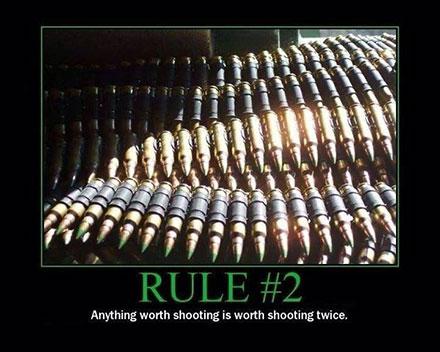Moving forward from our first installment, Rule 1, we come to today’s lesson, Rule 2.
We’re taking a look at the rules for a gunfight that was inspired by a series of memes I came across when I should have been doing something far more productive. I’m doing this in hopes of imparting some small piece of wisdom that may come in handy for someone some day. A gunfight isn’t something you get into every day. (If you do, you should seriously rethink your line of work or where you live, depending on which one is getting you shot at.) My hope is that some small word or phrase from this series will stick in a mind that may need it at that very critical point in their life. But enough. On to…
So, you’ve found yourself in a situation where you have to defend yourself. Hopefully, Rule 1 has sunk in and you have your gun with you. There’s no other way out of this situation except by using deadly force. For a normal human being, having to shoot another person is a horribly unnatural act. Unfortunately, your assailant has visited this violent encounter on you, and you have to respond.
“Those of us who have seen violent death up close, who have seen what high-powered bullets can do to living human tissue, have a horror of inflicting that nightmarish, never forgotten damage on a fellow human being. Perhaps the only more terrifying prospect is that such a fate should befall us or our loved ones. This is why we, a representative cross-section of America’s population, keep deadly weapons for personal defense.” ― Massad Ayoob, In the Gravest Extreme: The Role of the Firearm in Personal Protection
Now, let’s quickly move this away from the 9mm/45/357 debate this would spiral into left to its own devices. We know you carry a .45 because shooting twice is silly. This isn’t what today’s lesson is about. Today’s discussion will be about how much is enough? Don’t get ahead of me and start guessing numbers. There is no one right answer. (Kind of like a Common Core lesson, isn’t it? This way everybody gets to be special.)
Remember, we’re addressing this series from the point of view of a concealed weapons permit holder. As CWP holders we don’t shoot to kill. We don’t shoot to wound. We shoot to stop a threat.
So, when is enough enough? Laws vary from state to state. The general consensus is that you can engage and continue to engage an aggressor who you reasonably believe will cause you bodily harm or death until the aggressor no longer represents a threat. You’ll want to get an opinion, in writing, from your state’s Attorney General on what is considered defense in your locale. Go over this with the attorney you have identified to represent you in a shooting. You do have a post-shooting plan in place, don’t you?
Never forget that your assailant has a vote in how long the gunfight lasts and how many rounds you’ll have to fire. Some people are more resilient than others, and can absorb far more damage than you would think possible and continue to function. Your attacker’s physical conditioning, mental instability, use of controlled substances, or just the plain will to survive are just a few of the unknown to you factors you’re confronting.
You may have been taught to fire two rounds, assess the situation, and fire more rounds if necessary. This is fine in theory. In fact though, unless you are hardened to armed combat through experience, the engagement is probably going to be over before you realize it.
Remember that this is all going to take place very quickly. Forget everything you’ve seen in the movies about gunfights. They don’t happen that way. According to the FBI’s statistics, 95% of gunfights take place at a distance of zero to twenty one feet, most take place in low light conditions, on the average are over in three to five seconds with three to four shots usually fired, and, on average, one shot in four strikes someone.
Due to the phenomena known as tachypsychia, those three to five seconds may seem like years, or go by in a flash. Tachypsychia is induced by a number of things, usually physical exertion or a traumatic event, that can affect you by making events seem to slow down, or just become a speeding blur.
So that two rounds, assess, and re-engage if necessary probably isn’t going to be real high on your mind’s priority list. If you retain the presence of mind to pull the trigger, you’ll probably continue to do so until your gun clicks empty or your assailant goes down. In the vast majority of debriefs of law enforcement officers and servicemembers involved in gunfights, they rarely remember how many rounds they fired.
So, if your attacker flees at the sight of your gun, he no longer presents a threat, so no rounds fired is the correct answer. If you fire on and hit your attacker and they flee, stop their assault, or collapse and are unable to commit any further aggression, the answer is one round. If your attacker absorbs an entire magazine of ammunition and continues the assault, reload and keep defending yourself until the threat no longer exists.
As I said, there isn’t a numerically correct answer to the question as to how many rounds you will need to expend. You shoot until the threat is stopped. No adding extra rounds into the back of a fleeing attacker, no coup de grace to a downed assailant.


